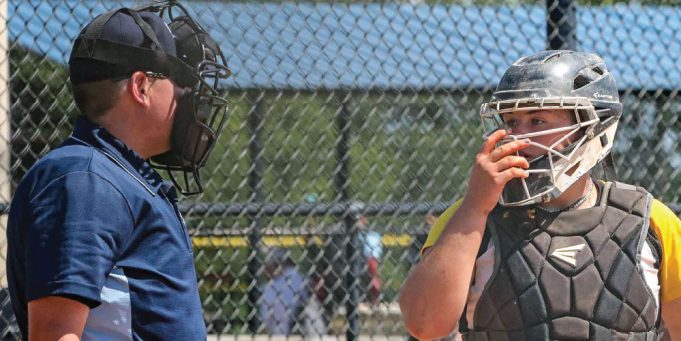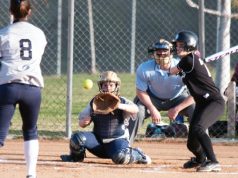“B
lue, where was that?”
If you have not heard this question at least a hundred times, you’re probably still in your first year as an umpire. Whether the question is coming quietly from the catcher or being shouted by the coaches on the bench, it’s important to remain professional and not take the question personally. With that being said, how do we handle players or coaches who question our strike zone?
We all know we will be questioned periodically. We’re not perfect by any means, but few people, other than umpires, realize how many pitches we’re required to call each game. The average number over a seven-inning game is about 300 pitches, depending on the level and what source you use to verify. During the course of those 300 pitches, one or two are going to be just a bit high or a little outside the zone. From the sidelines, we’ll hear a small groan on the first one. The catcher might frame the pitch for a fraction of a second longer than normal or perhaps turn her head just a little to ask, “Where was that?” On the second one, the groan is a little louder and longer, the frame just a bit longer, and the catcher may turn her head a bit more before asking again. Try to understand none of these actions, yet, are meant to show you up. As we grow as umpires, how we handle these actions determines our ability to be game managers just as much as keeping a good lineup card or any of the other small stuff no one really ever notices during the game.
First and foremost, when the catcher asks, be honest; “Catch, that was a bit outside.” Or, in the event you realize you missed it, “Catch, I missed it.” It is OK to admit it to the catcher, just try to not make it a habit. The higher the level you officiate, in most cases, the catcher will have your back and she’ll relay to the bench where the pitch missed. Building a rapport with the catcher will help facilitate this process. Under no circumstance should our actions or responses be directed to the bench. Do not use your hands or head movements to indicate where the pitch missed. At the lower levels of officiating, we see this all too often. Then, as umpires try to progress to higher levels, it creates nothing but trouble for them when they engage with the benches during the game.
Think of why it’s never a good idea to interact with the bench. Primarily, if you communicate with one dugout, the opposing dugout is going to expect the same. Again, using game management as a rule of thumb, how will the fans and players view the interaction between the umpire and the bench? In every scenario, engaging with the benches will be viewed as the coaches controlling the game, not the umpire. Using the catcher as your means of communication keeps the game going much smoother and presents a less-hostile environment. At the end of each inning, the catcher can speak with the coaches to relay any additional information needed.
At some point in time, there’s going to be a coach, assistant coach or, worst of all, a catcher who steps over the line. Let’s look at how to handle this in terms of situational management. If the catcher starts to frame every pitch or shows any form of verbal or physical disgust over a call, take control of the situation by informing the catcher, “That’s enough, this is your warning.” Some words of wisdom though, don’t be overly dramatic with this warning. Do it subtly as you’re coming out of your stance or getting back into it, or take the time to brush off the plate and speak to the catcher without directly looking at them. Just like we don’t want to be embarrassed, neither does the catcher. If the catcher continues to hover near that line as the game progresses, grab the coach’s attention between innings.
Avoid walking over to the bench and embarrassing the catcher by having the conversation with the coach right in front of her. Good coaches will feel obligated to fight for their catcher in front of the other players. Try to avoid that situation.
If the time comes when the catcher cannot remain in the game, we’ve done our due diligence by giving the catcher three chances to continue her duties. Our objective as umpires is to do everything in our power to keep players in the game, but when they cross the line, there are consequences.
On the other hand, when assistant coaches feel empowered to complain about our zone, a short leash is always best. When the occasional groan turns into specific comments, action should be taken immediately. Time should be called and just a few steps should be taken toward the offending bench. Announce, “Coach this is your warning for arguing balls and strikes.” Make a point of quickly noting it on the back of the lineup card, include inning and then something small like “VW” for verbal warning. The next time a comment comes from the bench (and you’re certain it’s the assistant coach) pull the trigger and eject the assistant. There’s no place in the game for assistant coaches to try to impose their will. They’re there at the pleasure of the head coach and are not necessary to conduct the game. Ejection sounds harsh, but it’s a great learning curve for everyone involved.
Just like starting players, head coaches should be given more leeway to remain in the contest. Any time a question sounds more like a complaint, action should be taken. Same as with the assistant coach, step away from behind home plate and provide a verbal and written warning. The difference in ejecting the head coach should be any follow-up comments from the dugout that could be ignored, should be. That doesn’t mean ignore the next two or three chirps; it means wait for the comment from the coach that breaks the camel’s back indicating it’s time for him or her to go.
Arguing balls and strikes has long been considered part of the game, but is it really? All four codes specifically address arguing balls and strikes. USA Softball rule 4-8c, NFHS rule 3-6-15, USSSA rule 11-2r and NCAA rule 13.8.4 makes it an ejectionable offense (after a team warning if warranted). The NCAA has wisely added a note that states: “… A coach or player may, on occasion, request feedback regarding the specific location of a pitch or ask a point of rule without applying rule 13.8.4 as long as it is not made in an argumentative fashion and does not delay play.” There is a fine line between questioning and arguing and umpires must judge what the coach is looking for. If coaches ask you where the pitch is after every pitch, that is a problem. If they ask here and there on a couple of close pitches throughout the game, that is acceptable. If a coach or player crosses from asking where a pitch is to telling you where the pitch is, that is no longer questioning and should be dealt with accordingly.
Over the course of a season and career, there are going to be very few games where we can honestly say, “I didn’t miss a pitch.” The reality though is the vast majority of games we do, and given the tens of thousands of pitches we see, we are going to miss a pitch or two. Missing a few pitches during a game does not make us bad umpires, provided it isn’t always a 3-2 pitch on the corner that we miss.
When it comes to warnings and ejections, know where the line is, draw that line in the sand and then use the tools given to you by the code you are working that day to manage the situation, but be careful not to make empty threats like, “One more word and you’re gone.” Managing the game and keeping a lid on the comments and actions of the players and coaches are what will make us all better umpires generating respect when we walk on the field. It also makes it easier for the next umpire who takes that field.
What's Your Call? Leave a Comment:
Note: This article is archival in nature. Rules, interpretations, mechanics, philosophies and other information may or may not be correct for the current year.
This article is the copyright of ©Referee Enterprises, Inc., and may not be republished in whole or in part online, in print or in any capacity without expressed written permission from Referee. The article is made available for educational use by individuals.


















